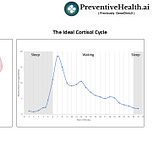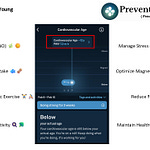Do you wake up tired—even after a full night’s sleep? Or crash hard at 3 p.m. and reach for caffeine or sugar? Do you wake up between 2–4 a.m. and can’t get back to sleep? Have you seen your glucose or HRV metrics look fine during the day, but experience poor sleep and recovery at night? You may be dealing with cortisol dysregulation.
When we hear the word cortisol, most of us think “stress hormone.” And therefore, we view it negatively, as something to avoid. But it’s far more nuanced than that. Cortisol is your body’s built-in metabolic thermostat, orchestrating a symphony of processes—from glucose regulation to immune control, muscle preservation, sleep cycles, inflammation, and even fat distribution.
Surprisingly, there are times of day when you actually need cortisol to rise for optimal function. Intrigued? Read on.
Cortisol 101: What It Actually Does
Cortisol is a hormone made by your adrenal glands, when your brain signals them to do so. It works through the HPA axis - the Hypothalamus (in the brain) detects stress and sends a signal to the Pituitary gland (also in the brain), which in turn sends a signal to the Adrenal glands (on top of your kidneys). This causes the Adrenal gland to release cortisol. See figure below.
Importantly, once cortisol is released into the bloodstream, it also signals back to the hypothalamus and pituitary to reduce further output—this negative feedback loop helps maintain hormonal balance and prevent overstimulation. When this feedback loop malfunctions, it can lead to chronic stress states or adrenal fatigue.
Cortisol follows a precise internal body clock called circadian rhythm. When it works well, it gives you stable energy in the morning, metabolic flexibility during the day (your body can switch between burning glucose and fat), and restful sleep at night.
How The Cortisol Cycle Ideally Works
🕕 Around 4–6 AM: Your brain (hypothalamus and pituitary) signals your adrenal glands to start producing cortisol.
🕗 30–45 Minutes After Waking: Cortisol surges to give you energy, raise blood sugar slightly, and help your body face the day. This surge is beneficial.
🕐 Afternoon to Evening: Cortisol gradually declines, allowing your body to wind down.
🕛 11 PM to 2 AM: Cortisol hits its lowest point. This drop allows melatonin to rise, promoting uninterrupted, restorative sleep.
What Disrupts The Cortisol Cycle
Modern lifestyle habits—late meals, overtraining, ultra-processed foods, artificial light at night, emotional stress, and erratic sleep patterns—all act as stressors. Even something as subtle as low electrolyte levels (which your adrenal glands help regulate) can spike cortisol as your body enters “alert mode.”
This flattens or inverts your cortisol curve so that cortisol no longer rises and falls at the right times. The result? Fatigue, belly fat, fragmented sleep, elevated glucose, low libido, and impaired immunity—even when blood work appears “normal.”
Why Cortisol Matters for Longevity
Cortisol isn’t just about short-term stress; it also impacts your long term-health. When it’s dysregulated:
Muscle breakdown accelerates (which is a major problem given that muscle mass is one of the best predictors of longevity)
Insulin resistance increases (bad for lifespan and energy levels as discussed repeatedly in my various blog posts)
REM and deep sleep fragment (undermining mitochondrial repair and memory consolidation, both of which provide critical protection against cancers, heart disease and neurodegenerative conditions)
ApoB and triglycerides start to creep upward, and visceral fat accumulates (cardiovascular risk rises)
The MESA study and others have shown that flattened cortisol rhythms correlate with higher mortality, even after adjusting for age, comorbidities, and inflammation markers. A flatter cortisol slope, rather than the rise and fall as shown in the figure above, is linked to a 42% to 90% increased mortality risk. That’s serious stuff, but rarely discussed in annual checkups.
How to Test Cortisol Levels
Because of the varying cortisol levels through the day, doing a single serum cortisol test tells you almost nothing. In fact, your stress around the blood draw may spike your cortisol level anyway. A more useful test is the 4-point salivary cortisol profile. It tracks cortisol at waking, 30 minutes after, afternoon, and bedtime. It reveals your rhythm, not just a one-time number—and avoids blood draw–induced skewing.
It’s not a routine test, but for those facing unexplained fatigue, anxiety, or poor sleep, it can offer real insights.
How to Fix a Broken Cortisol Rhythm
Here is a list of things I do to ensure my cortisol cycle stays on schedule:
Morning light: Get outside within 30 minutes of waking. This anchors my cortisol rhythm and resets melatonin for the night. I do this quite religiously because I tend to wake up early and am usually on calls so I can take my calls while strolling outside.
Protein at breakfast: As discussed in my protein post, I aim for 30–40g of protein at breakfast. This is usually with a combination of a grilled chicken something (20 - 30 grams), nuts (5 grams), 2 eggs (12 grams)
Train before 5 p.m.: Exercise is a cortisol spike. Do it early to avoid disrupting your sleep. I tend to exercise between 3 pm and 5 pm on most days.
No late meals: Eating late creates a cortisol-insulin tug-of-war. Let your pancreas clock out on time. I usually tend to finish my dinner by 7 pm on most days (although I do end up finishing at 8 pm on some days).
Waking at 3 a.m.? A small glass of warm water with sea salt can calm the adrenals and help you fall back asleep. I have also described my successful experiments with the 4-7-8 breathing technique and have recently been experimenting with the eyerolling technique that seems to be working quite well.
Wind down with purpose: Use magnesium glycinate, glycine, or L-theanine to relax your nervous system and gently lower nighttime cortisol. I have stopped doing this because the approaches in the previous point are working well, and I prefer to avoid supplements unless they are necessary.
Bottom Line: Make Cortisol Work for You
Cortisol isn’t your enemy. It’s a rhythm regulator. But if you don’t train it, it trains you—into fatigue, insomnia, and accelerated aging.
As always I welcome your thoughts and would love to have you share your experiences in the comments.
If you haven’t, I hope you’ll join the waitlist for the Longevity Lab community today (it’s FREE), and invite your friends and family too. In addition to providing recommendations on health and wellness products, I interview one domain expert every Thursday at 8:30 am PST / 9 pm IST, and talk about the latest research in preventive health across their various areas of expertise. Recent talks have been with clinicians across the US and India in Endocrinology, Internal Medicine, Orthopedics, Oncology, while upcoming talks are with experts in Metabolic Health, Genetics, Strength Training, GI and Neurology. To join, scan the QR code below or click on the WhatsApp community link here
Disclaimer: The information provided in this article is for educational and informational purposes only. It is not intended as a substitute for professional medical advice, diagnosis, or treatment. Always seek the advice of your physician or other qualified healthcare providers with any questions you may have regarding a medical condition or wellness program. Reliance on any information provided in this article is solely at your own risk. The author and publisher of this article make no representations or warranties, express or implied, regarding the completeness, accuracy, reliability, suitability, or effectiveness of the information contained herein. The inclusion of specific products, services, or strategies in this article does not imply endorsement or recommendation. The author and publisher disclaim any liability for any adverse effects or consequences resulting from the use or application of the information presented. You are encouraged to consult with a qualified healthcare professional before making any changes to your diet, exercise routine, or lifestyle.
















Share this post